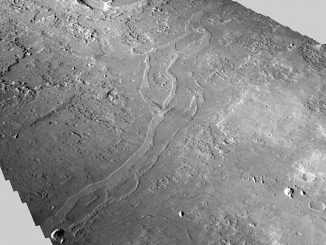The European Space Agency’s Cosmos channel will live stream the transit (see below) from 10:30am BST (09:30 UTC). You may also ask the experts questions via Twitter using the #MT2016CESAR hashtag.
Satellite views of Mercury’s transit of the Sun
At 11:30am BST (10:30 UTC) on Monday, 9 May, NASA’s Solar Dynamics Observatory (SDO) will begin watching Mercury move into view against the corona of the Sun. Since the SDO satellite is in an inclined geosynchronous orbit about the Earth, this is about 45 minutes before it is visible against the Sun from ground-based observers. SDO have created a special website to let you watch the transit as short movies in almost real time.
The image below shows the predicted positions of Mercury against an actual solar image from 3:14pm BST (14:14 UTC) on 8 May. The black circles are about the size of Mercury and are spaced 30 minutes apart. There are no sunspots along the path of Mercury and only a few areas of strong magnetic field (the bright regions in this image).

The Sun’s corona is also smaller than it has been, meaning Mercury will come into view in the satellite’s extreme-ultraviolet (EUV) images less than an hour before first contact (12h12m24s pm BST for the centre of the UK). Although SDO will be taking images all the time, the special modes will start 45 minutes before first contact and end 45 minutes after fourth contact (7h40m34s pm BST in the heart of the British Isles).
Along with the full-disc view of the Sun, SDO will provide several zoomed views. These views are shown by the boxes that are drawn on the image. You can see that the spacecraft’s EUV telescopes will see Mercury blocking the corona before it moves onto the disc. All of the boxes are built in a 16×9 ratio that fit nicely onto a 1080p screen.
- The Ingress box will show the images from when Mercury moves over the edge of the Sun at the beginning of the transit. This includes first and second contact (when Mercury first touches the edge of the Sun and when Mercury moves completely onto the Sun in visible light). It will also show Mercury against the corona of the Sun before first contact in the extreme-ultraviolet (EUV) channels;
- The Tracking box will follow Mercury as it moves across the disc;
- The Egress box images will show the data when Mercury moves into that box as it exits the Sun. It will not be available until about 6:30pm BST (17:30 UTC). This box will show third and fourth contact (when Mercury starts leaving the disc of the of Sun and the last instant it touches the edge of the Sun, again in visible light);
- The Full Passage box will be updated throughout the transit so that you can watch the entire path of Mercury across the Sun.
Each view is available as a self-updating movie, by clicking on the picture shown on the website, and as an mp4 movie, which can be seen by clicking on the View/Download mp4 button below the image. Depending on its settings, your browser will either show the movie or download it. The mp4 movies will also be regularly updated as new images arrive, but are not automatically updated on your browser.
Other online streaming sources
NASA’s Goddard Space Flight Center in Maryland will also provide a feed of the transit’s progress.
Another webcast of the transit will come from Slooh.com.
Follow the 2016 Mercury transit on your mobile or tablet

Inside the magazine
Find out all you need to know about observing Mercury safely during the transit and the other solar system bodies currently in the night sky in the May 2016 edition of Astronomy Now.
Never miss an issue by subscribing to the UK’s biggest astronomy magazine. Also available for iPad/iPhone and Android devices.




